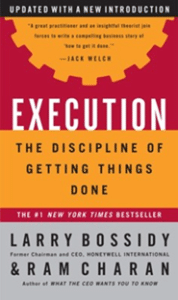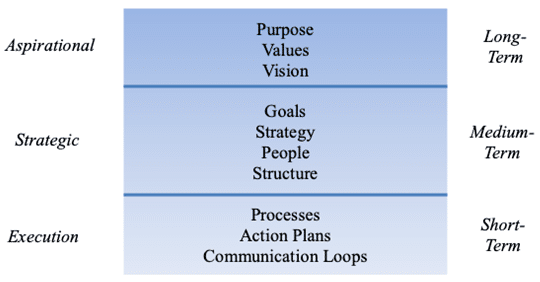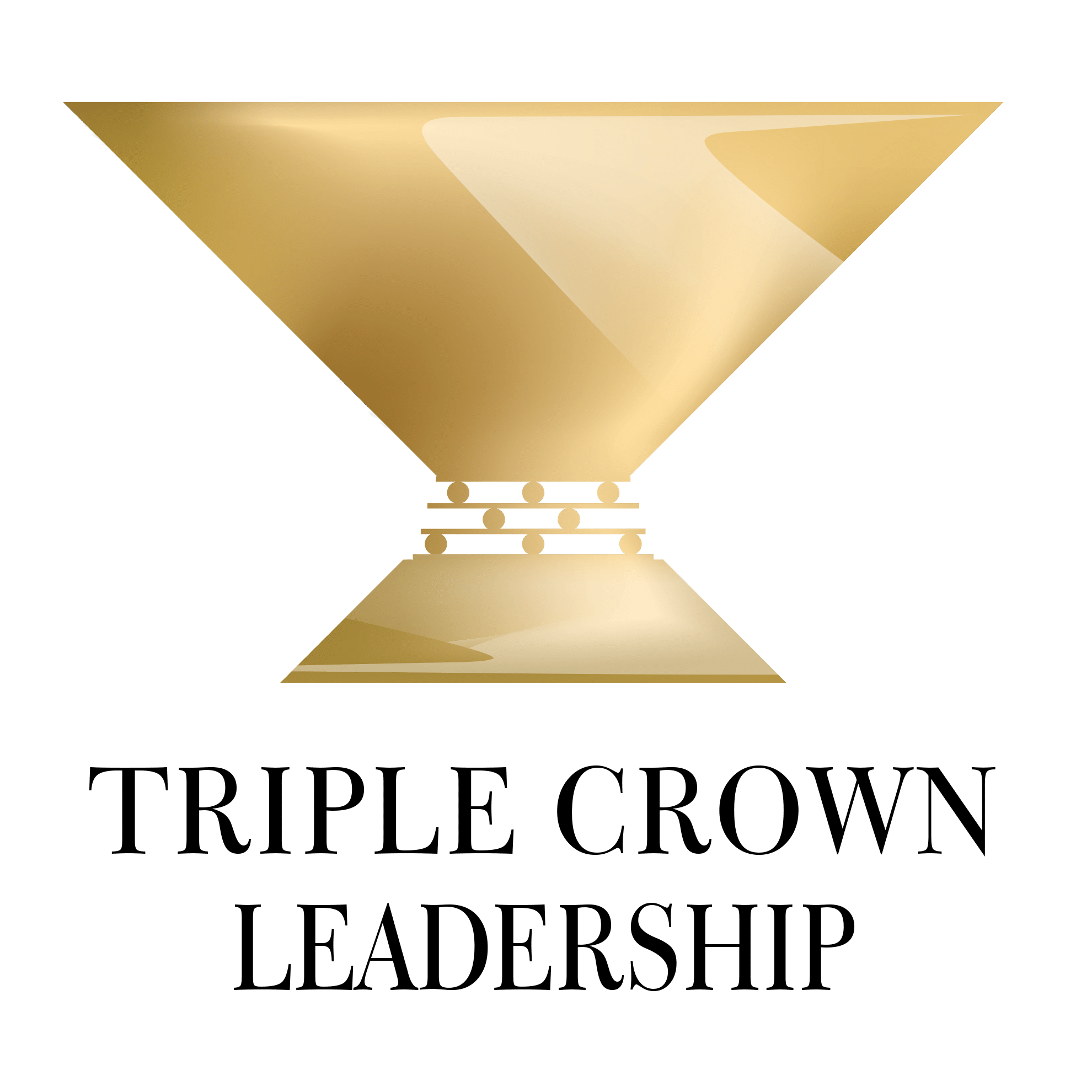Article Summary:
Creating an execution-driven organization is essential for leaders. There are specific tasks leaders can do with strategy, people, and operations to align their organization to execute well. Good leaders embed excellent execution into the culture of their organization.
+++
Execution entails carrying out a strategy, plan, directive, or course of action. Good leaders ensure the disciplined, ethical execution of key functions that drive the necessary results of their organization.
Effective execution is essential. If we can’t execute, we won’t survive long as a leader.
Much has been written about purpose, values, vision, culture, leadership styles, and more, but the literature on execution is much less robust. A great resource is the book, Execution: The Discipline of Getting Things Done, by Larry Bossidy, the former CEO of Honeywell, and Ram Charan, author and business consultant.

“Execution is the ability to mesh strategy with reality, align people with goals, and achieve the promised results.”
-Larry Bossidy, former CEO of Honeywell and author
They say execution is “the missing link between aspirations and results.” Execution is a disciplined, continuous process that links the strategy of the organization to its people and the operations they work in. Done well, execution converts the organization’s strategy into excellent results.
Execution is not a solo performance by any single leader. It’s a group performance that requires certain leadership skills.

Leadership Derailers Assessment
Take this assessment to identify what’s inhibiting your leadership effectiveness. It will help you develop self-awareness and identify ways to improve your leadership.
Execution Involves Alignment
We’ll blend what the authors of Execution wrote about linking strategy, people, and operations with what we wrote in Triple Crown Leadership: Building Excellent, Ethical, and Enduring Organizations about alignment, the fifth advanced leadership practice we described.
Alignment is a transformational leadership process that gets people moving in the same direction rather than working at cross purposes. (See our article, “How to Align Your Organization for Peak Performance.”) Alignment has three clusters of steps: aspirational, strategic, and execution:

In their book, Playing to Win: How Strategy Really Works, A.G. Lafley (former chairman and CEO, Procter & Gamble) and Roger Martin (former Dean, Rotman School of Management) defined strategy as “An integrated set of choices that collectively position the firm in its industry so as to create sustainable advantage relative to competition and deliver superior financial returns.” We think of strategy as how the organization will achieve its primary goals.
We recommend that major goals be set for each stakeholder, such as customers (e.g., market share growth), workers (e.g., worker satisfaction levels), the community (e.g., reducing the negative externalities the organization creates), and the owners (e.g., financial performance). The organization’s top goals should cascade down into subgoals for the departments. The goals should be measurable and prioritized, and they should cover the short- and medium-term time frames, a few years into the future. (See our article, “The Missing Links in Goal Setting.”)

Alignment Scorecard
When organizations aren’t aligned, it can reduce performance dramatically and cause frustration and dysfunction. With this Alignment Scorecard, you can assess your organization’s level of alignment and make plans for improving it.
Responsibilities of Leaders for Execution
Bossidy and Charan outline the responsibilities leaders have to ensure effective execution. Good leaders:
- set the direction of their organization through a strategy
- select and empower their people to achieve that strategy
- coordinate the operations of the organization
Good leaders don’t micromanage their people or disempower them. To create excellent execution, good leaders:
- act ethically to engender trust
- know their people and the organization they lead as well as their competitors and the surrounding environment
- acknowledge the realities the organization faces
- clearly link the strategy to their people and the operations
- analyze the gaps between the desired results and what’s being achieved currently
- stay focused on the key priorities—and help others keep focused
- ask many questions
- communicate results far and wide
- follow up with people continuously
- recognize and reward people who execute well more than those who don’t
Let’s turn our attention now to the key roles Bossidy and colleagues defined for excellent execution.
Strategy Setting
The strategy:
- should be developed by line managers who understand the competitive environment
- must have measurable milestones for the short-, medium-, and long-term
- should be clear, compelling, and sharply focused
- must be within the capabilities of the organization to accomplish
- must be approved by the highest executive in the organization
- must then be cascaded down the organization for each subgroup to align their work to execute the strategy
- should be summarized on one page for widespread distribution throughout the organization so that everyone understands what’s to be done

Personal Values Exercise
Complete this exercise to identify your personal values. It will help you develop self-awareness, including clarity about what’s most important to you in life and work, and serve as a safe harbor for you to return to when things are tough.
People Execute the Strategy
Bossidy and Charan emphasize getting the right people in the organization to execute the strategy. They recommend that senior executives spend about 40% of their time on people selection, placement, and development.
For proper execution, such people:
- must be decisive, proven doers who are values-based and energize others (Too many organizations give preference to high-IQ thinkers who may be visionaries but who have trouble getting results through other people.)
- must actively lead others, ensuring clear understanding of priorities and appropriate assignment of tasks
- are skilled at unleashing the talents of others through empowerment and delegation
- actively follow up with their people
- develop their people actively through valuable experiences, learning opportunities, coaching, feedback, education, and training
- actively recognize, reward, and promote people who execute well according to the organization’s shared values
- are quick to say “no” to ideas and suggestions that don’t align with the strategy
- actively reassign or terminate those who cannot execute well
When good people engage in these behaviors consistently, it motivates others to become more engaged and participate more effectively in pursuing the organization’s goals.
Execution within the Operations
Leaders of the organization’s subgroups (departments, divisions, and other groups) break down the higher-level goals and strategies and translate them into corresponding work activities. They:
- create frequent communication loops of daily, weekly, monthly, and quarterly meetings
- create simple, visual scorecards or dashboards of measures and metrics that reveal what’s really happening in their areas of responsibility
- use leading indicator metrics (e.g., the number of high-level sales leads currently pursued rather than the lagging indicator of sales achieved)
- use critical discussions in their regular meetings to understand what’s going right, what’s not, and how to pivot to achieve the desired results
- develop a cadence of regularity that keeps everyone focused and aware of activities and progress
A Culture of Excellent and Ethical Execution
A high-performance culture has many elements. It’s collaboratively set and actively enforced by everyone in the organization. The ideal culture embraces the shared purpose, values, and vision of the organization.
The culture should embrace excellent and ethical execution. When that happens, the organization hits its critical targets to survive and thrive. People focus on the proper priorities. They’re connected and they collaborate rather than working at cross-purposes or feuding. People make midcourse corrections frequently and seamlessly as the competitive and economic environment changes. A disciplined culture of excellent and ethical execution becomes a reality, and people thrive.
Reflection Questions
- Does your organization execute well?
- If not, what will you do to improve your execution?
- When will you start, and with whom?
Tools for You
- Leadership Derailers Assessment to help you identify what’s inhibiting your leadership effectiveness
- Personal Values Exercise to help you determine and clarify what’s most important to you
- Alignment Scorecard to help you assess your organization’s level of alignment

Leadership Derailers Assessment
Take this assessment to identify what’s inhibiting your leadership effectiveness. It will help you develop self-awareness and identify ways to improve your leadership.
Related Articles
- “How to Align Your Organization for Peak Performance”
- “How to Build a Culture of Character”
- “How Good Leaders Handle Factions and Office Politics”
- “Good Leaders Learn to Say No“
- “The Keys to Great Meetings“
- “How Great Leaders Maintain Exceptional Focus“
Postscript: Quotations on Execution
- “Ideas don’t make you rich. The correct execution of ideas does.” -Felix Dennis, entrepreneur and author
- “No excuses. No explanation. You don’t win on emotion. You win on execution.” -Tony Dungy, former professional football coach and author
- “A good plan violently executed now is better than a perfect plan tomorrow.” -George Patton, U.S. Army general
- “Execution is everything.” -John Doerr, venture capitalist
- “To me, ideas are worth nothing unless executed. They are just a multiplier. Execution is worth millions.” -Steve Jobs, co-founder and former CEO of Apple
- “The thing that keeps a business ahead of the competition is excellence in execution.” -Tom Peters, author and organizational consultant
- “Vision without execution is hallucination.” -Thomas Edison, American inventor
- “Most leaders would agree that they’d be better off having an average strategy with superb execution than a superb strategy with poor execution.” -Stephen R. Covey, leadership author
- “When it all comes down to it, nothing trumps execution.” -Gary Vaynerchuck, entrepreneur and author

Triple Crown Leadership Newsletter
Join our community. Sign up now and get our monthly inspirations (new articles, announcements, opportunities, resources, and more). Welcome!
+++++++++++++++++++++++
Gregg Vanourek and Bob Vanourek are leadership practitioners, teachers, and award-winning authors (and son and father). They are co-authors of Triple Crown Leadership: Building Excellent, Ethical, and Enduring Organizations, a winner of the International Book Awards. Check out their Leadership Derailers Assessment or get their monthly newsletter. If you found value in this, please forward it to a friend. Every little bit helps!


